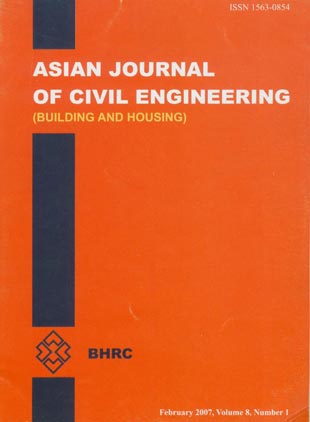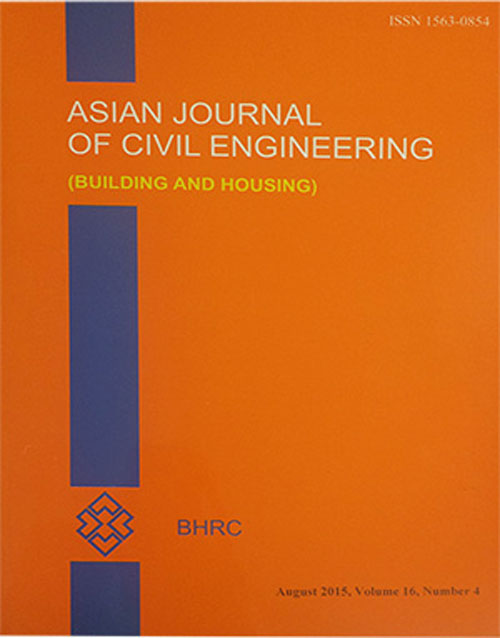فهرست مطالب

Asian journal of civil engineering
Volume:8 Issue: 1, February 2007
- 112 صفحه،
- تاریخ انتشار: 1386/12/20
- تعداد عناوین: 8
-
-
Page 1This paper describes a study conducted to determine the surface shape of membranestructures with fixed edges. Results obtained experimentally by taking coordinatemeasurements in three dimensions from scale down physical models are compared withcomputed values based on the formulation of the force density method for determining thesurface shape. A program in C++ is developed in order to assist in the computation. It is observed that the results under minimal surface conditions are in close agreement and the formulation can thus be applied practically to predict the surface shape of membranestructures.
-
Page 13The incorporation of admixtures in the cementing materials modifies their rheological andmechanical properties by a granular effect, a physicochemical and a chemical effect.In order to evaluate the chemical reactivity of the admixtures, we used an approach which consists on the volume substitution of the cement by the admixture in mixtures of which the absolute volume of the whole constituents are preserved constant and the workability fixed by using superplasticizers. Under these conditions, the mixtures have a volume of the flexible phase and an initial porosity constant and then, only the clean chemical effect of the admixture is taken into account.
-
Page 25In this study, the effects of important ground motion parameters and site conditions on linear and nonlinear, pseudo-acceleration and input energy response spectra are evaluated. These parameters include magnitude, epicentral distance of recording station, strong motion duration, soil conditions, damping and ductility. A total of 620 Iran’s earthquake timehistories (1240 horizontal and 619 vertical components) recorded by ISMN (Iranian Strong Motion Network) were selected for this study. The accelerographs are classified based on parameters of earthquake ground motion and site conditions. Statistical investigations are made on the response spectra of the accelerographs of these groups and it is shown that these parameters significantly affect the shape and magnitude of pseudo acceleration and input energy response spectra. Finally, based on these studies, some pseudo acceleration and yield acceleration design spectra are proposed for the region of Iran.
-
Page 49This paper presents the experimental investigations carried out to study the effect of use of bottom ash (the coarser material, which falls into furnace bottom in modern large thermal power plants and constitute about 20% of total ash content of the coal fed in the boilers) as a replacement of fine aggregates. The various strength properties studied consist of compressive strength, flexural strength and splitting tensile strength. The strength development for various percentages (0-50%) replacement of fine aggregates with bottom ash can easily be equated to the strength development of normal concrete at various ages.
-
Page 63In the past three decades, steel shear walls have been used in numerous tall buildings as aresistant system against earthquakes and wind loads. The advantages of using these systems in seismic resistant structures include enhanced stiffness, strength and ductility. In addition, more stable hysteresis characteristics are resulted which leads to considerable capacity for absorption of plastic energy. In the present paper, the elasto-plastic behavior of steel shear walls is presented by performing cyclic tests on six different specimens. The aspect ratio of shear walls and also the thickness of infilled panels are considered as variables and their effects on the cyclic behavior are studied thoroughly. Finally, the experimental results are compared with theoretical analysis and a good agreement is observed.
-
Page 77This paper is devoted to the simultaneous weight and stiffness optimization of twodimensional structures. The necessary optimality conditions are derived and the obtainedoptimality criterion is briefly explained. Based on the paradigm of cellular automata, a localrule is constructed which alleviates the well known problems of mesh dependency andchecker-boarding in topological structural optimization. It is shown that implementation ofthis algorithm is useful in prevention of the formation of undesirable members in theresulting layouts. In this approach, contrary to the conventional topological structuraloptimization methods, the shape and boundaries of the two dimensional continuum are not fixed and can undergo considerable changes during the optimization process. Hence, This approach may be considered as a generalized structural optimization method. Todemonstrate the advantages of the method a couple of examples are presented.
-
Page 89This paper presents results of an experimental investigation of actual performance of thereinforced concrete beam in bond under flexure, when reinforced with tension steel (TMTRebar) is going to consider. The major variables studied include lap length and percentageof steel. Five different lap lengths and three different type longitudinal steel were used.Bond strength comprises two basic components identified as adhesive bond and frictionbond. It is observed that adhesive force increases with the increase in compressive strengths of concrete (34 MPa and 37 MPa concrete). The frictions bond component is observed to increase with the increase in bar diameter. Frictional bond strength exhibits increasing characteristics with increase in lap length up to about 400 mm. beyond which it remains constant. For the same lap length, it is observed that bond strength increases by as much as 35 percent with increasing bar diameter. The value of development length obtained using ACI 318: 1999, BS 8110: 1985 and IS 456: 2000 is compared, it is observed that the value of development length obtained in tension using IS Code is 8% more as compared to BS Code and 11% more as compared to ACI Code, while the development length obtained in compression using IS Code is 3.5 % more as compared to BS Code and 17 % more as compared to ACI Code.
-
Page 97A combination of improved genetic algorithm and neural networks is proposed to find theoptimal weight of structures subject to multiple natural frequency constraints. The structural optimization is carried out by an evolutionary algorithm employing the discrete design variables. To reduce the computational time of the optimization process, the natural frequencies of structures are evaluated by using properly trained back propagation (BP) and wavelet back propagation (WBP) neural networks. The numerical results reveal the robustness and high performance of the suggested methods for the structural optimization with frequency constraints. It is found that the best results are obtained using WBP network. Keywords: Natural frequency, optimal design, genetic algorithm, wavelet, back propagation, neural network


